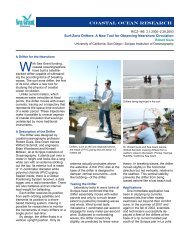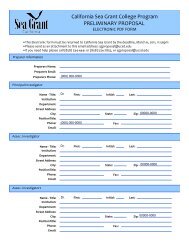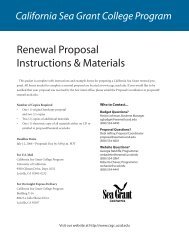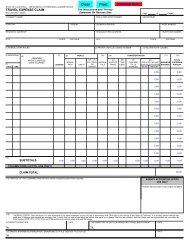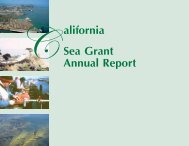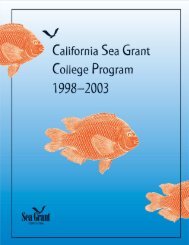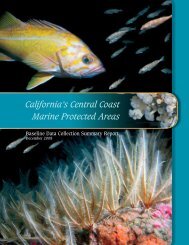Crescent City Profile - California Sea Grant
Crescent City Profile - California Sea Grant
Crescent City Profile - California Sea Grant
- No tags were found...
Create successful ePaper yourself
Turn your PDF publications into a flip-book with our unique Google optimized e-Paper software.
16Although the trawl fishery for whiting is managed under the Groundfish FMP, it is a distinctfishery in many respects, and is discussed separately.17See Leet et al. 2001 and Starr et al. 2002 for descriptions of these fisheries and gear types.18A second charter, Golden Bear Fishing Charters, also operates out of <strong>Crescent</strong> <strong>City</strong>; however,information was not available during fieldwork for this project.19The 1981 start date for this analysis is based on the availability the Pacific States MarineFisheries Commission’s (PSMFC) PacFIN database, which integrates Washington, Oregonand <strong>California</strong> commercial fishery landings data to provide a consistent coast-wideelectronic record of landings from 1981 forward. The PacFIN data for <strong>California</strong> are basedon the C-MASTER data provided by CDFG to the PSMFC.20Throughout we abbreviate the names of these fisheries as follows: albacore for albacoretroll, coonstripe shrimp for coonstripe shrimp pot, crab for crab pot, groundfish trawl fornonwhiting groundfish trawl, rockfish for rockfish/lingcod hook-and-line/pot, sablefish forsablefish hook-and-line/pot, salmon for salmon troll, and whiting for whiting trawl.21Because multiple species may be caught during a fishing trip, trips are measured by assigningeach delivery to the fishery accounting for the greatest (i.e., plurality of) ex-vessel valueassociated with that delivery. In some cases, fishing for particular combinations of speciesand/or using multiple gear types on a single trip is prohibited.22Note that crab season straddles the calendar year (December through July), and most landingsoccur within the first one to two months of the season (Hankin et al. 2001). As a result,activity reported for a given year may not correspond to that of a season, per se. Weanalyzed the data by calendar year for consistency with analyses for other fisheries, mostof which have seasons that lie within the calendar year.23In 2005, to prevent a recurrence of this situation, the state of Oregon prohibited fishermenfrom delivering fish caught off the Oregon coast to buyers in <strong>California</strong> without an Oregonreceiver’s license.24Because groundfish are taken as bycatch in the fishery, the shrimp trawl fishery is subject tofederal groundfish regulations as well (Frimodig et al. 2009).25Because the fishery did not begin until 1992, the averages reported are only for the 17-yearperiod (1992-2007).26The U.S. whiting fishery mostly occurs off Oregon and Washington and is conducted byfishermen in the shore-based, mothership, tribal, and catcher-processor sectors (Helser etal. 2008).27This is an area for further economic research. Many fishery participants alluded to muchhigher operating costs; however, we were unable to collect detailed expenditure data todemonstrate this.28Port-specific catch and effort estimates for the albacore and crab fisheries are not available.29Initiated by the state in 2004, the CRFS provides comprehensive estimates of effort and catchfor all recreational fishing modes and species. (Modes are the locations/facilities anglersfish from, and include: “manmade” structures, beaches and banks, CPFVs or charter boats,and private boats.)<strong>Crescent</strong> <strong>City</strong> Fishing Community <strong>Profile</strong> 56



